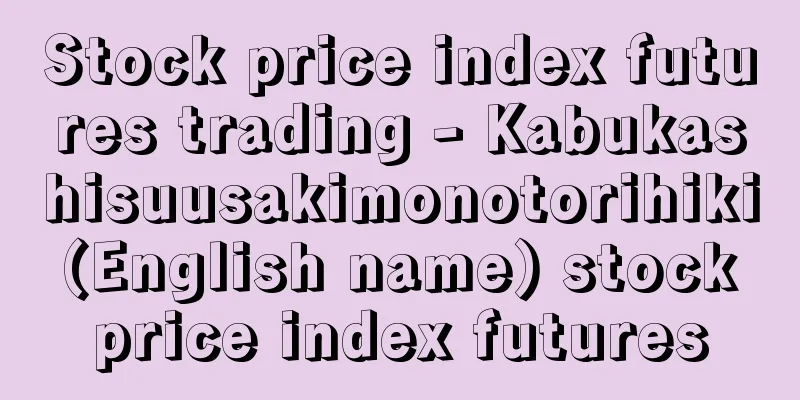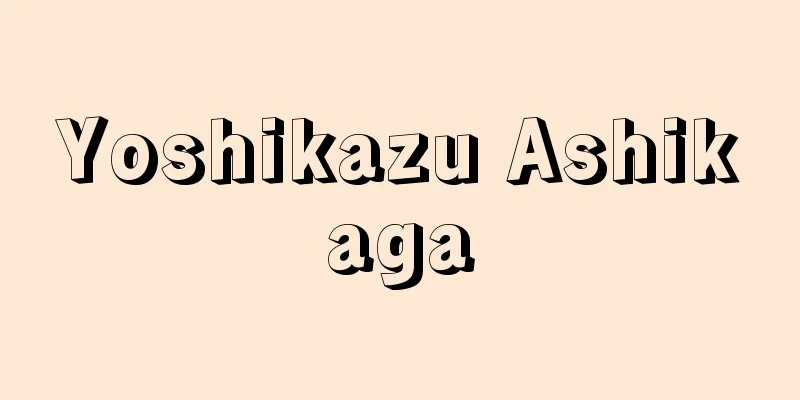Stock price index futures trading - Kabukashisuusakimonotorihiki (English name) stock price index futures

|
Futures trading uses stock price indexes as the underlying asset (the commodity to be traded, also called the base commodity). Futures trading is based on settling a certain amount of a commodity and its price by delivery on a certain date in the future (the final delivery date called the contract month), but also allows for the settlement of the difference between the initial contract price and the purchase price by making a counter sale (buying back a selling contract and reselling a buying contract) before the delivery date. By only allowing for a cash settlement, stock price index futures trading makes it possible to circulate the abstract concept of an index as a futures commodity. In addition, since it is traded on an exchange, the terms of the transaction are standardized, and it is possible to trade by depositing a portion of the purchase price as margin, so large transactions can be made with a small amount of capital. If a counter sale is not made by the delivery date, the special settlement index (SQ index) is used as the settlement price. The first futures contract based on a stock index was Value Line Stock Average Index futures, which started on the Kansas City Mercantile Exchange in the United States in 1982. Futures contracts based on Japanese stock indexes include the Nikkei Stock Average, which began trading in Singapore in 1986 and in Chicago in the United States in 1992. In Japan, it started in 1987 (Showa 62) on the Osaka Securities Exchange (now Osaka Exchange, hereafter referred to as OSE) with the unconventional "Stock Futures 50" (a package of 50 individual stocks), and the following year in 1988, TOPIX futures (Tokyo Stock Exchange, hereafter referred to as TSE) and Nikkei Stock Average futures (Nikkei 225 futures, OSE) were listed. Today, there are futures contracts on various stock price indexes around the world. In Japan, Nikkei 300 futures (Osaka Securities Exchange) were listed in 1994, industry-specific stock price index (electrical equipment, transportation equipment, banking) futures (Tokyo Securities Exchange) and industry-specific stock price index (High Tech 40, Financial 25, Consumer 40) futures (Tokyo Securities Exchange) in 1998, S&P/TOPIX 150 futures (Tokyo Securities Exchange) in 2001, MSCI-JAPAN index futures, FTSE Japan index futures, Dow Jones Industrial Average futures (NY Dow futures, Osaka Securities Exchange) in 2002, RN Prime index futures (Osaka Securities Exchange) in 2005, Nikkei 225 mini (Osaka Securities Exchange) in 2006, mini TOPIX futures, TOPIX Core 30 futures, and Tokyo Securities REIT index futures (Tokyo Securities Exchange) in 2008. In this way, a variety of stock price index futures contracts have been offered in Japan. However, when the Tokyo Stock Exchange Group and the Osaka Securities Exchange merged in January 2013 to form the Japan Exchange Group (JPX), in July of the same year, the markets were divided so that the Tokyo Stock Exchange handled the spot market and the Osaka Securities Exchange handled the derivatives market. As a result, all stock index futures traded on the Tokyo Stock Exchange began to be handled on the Osaka Securities Exchange. In January 2014, the JPX Nikkei Index 400 Futures (JPX Nikkei 400 Futures, Osaka Securities Exchange) was listed. In March of the same year, the Osaka Securities Exchange changed its name to the Osaka Exchange. Of the stock index futures traded in Japan, the Nikkei Average Futures and TOPIX Futures are the most historically representative and have the largest trading volumes (some of the index futures mentioned above have already been delisted or no longer available). Since stock index futures trading targets stock price indices that show the overall market trend, it can be said that it is trading the forest that is the stock market, rather than the tree that is an individual stock. Generally, among stock price fluctuation risks, the risk specific to individual stocks (unsystematic risk) can be controlled by diversifying investments, but the risk to which the entire stock market is exposed (systematic risk) cannot be controlled by diversifying investments and cannot be avoided as long as you participate in the stock market. The existence of stock index futures trading provides investors with a means to hedge such market risks by making it possible to implement a sell hedge strategy (hedge means to avoid. When a future fall in stock prices is expected, futures similar in characteristics to the owned portfolio are sold, and when the price actually falls, they are bought back at that stage to offset the losses incurred in the owned portfolio with the profits from futures trading). They also provide investors with investment opportunities such as speculation, which involves actively taking on the risk of stock price fluctuations in order to achieve high returns, and arbitrage, which involves taking advantage of the price difference between spot and futures, or between futures and each other. The reasons behind the introduction and expansion of the stock index futures trading system with these functions include (1) increasing uncertainty surrounding the economy, (2) the expansion of the size of the spot market, and (3) an increase in potential market participants. These factors are driving the activity of not only stock index futures trading, but also financial futures trading other than stock indexes, such as foreign exchange and interest rates. [Gen Takahashi December 14, 2015] [Reference items] | | | | | |Source: Shogakukan Encyclopedia Nipponica About Encyclopedia Nipponica Information | Legend |
|
株価指数を原資産(取引の対象となる商品。基礎商品ともいう)とする先物取引。先物取引は、将来の一定日(限月(げんげつ)とよばれる最終受渡し期日)に、一定数量の商品とその対価を受渡しにより決済することを基本としつつも、受渡し期日までの間に反対売買(売契約は買戻し、買契約は転売)を行って、当初の契約価格と売買価格との差金を支払いまたは受け取る決済を認めた取引制度である。株価指数先物取引は、差金決済のみを認めることで、指数という抽象的概念を先物商品として流通させることを可能にしている。また、取引所で取引されるため、取引条件などが標準化されており、売買代金の一部を証拠金として差し入れれば取引できるので、少額資金で大きな取引を行うことができる。なお、受渡し期日までに反対売買がなされなかった場合は、特別清算指数(SQ指数)が清算価格として用いられる。 株価指数を対象とした先物取引としては、1982年にアメリカのカンザス・シティ商品取引所でバリューライン平均株価指数先物がスタートしたのを嚆矢(こうし)とする。日本の株価指数を対象とした先物取引としては、日経平均株価が1986年にシンガポールで、1992年からはアメリカのシカゴでも取引されている。日本国内においては、1987年(昭和62)に大阪証券取引所(現、大阪取引所。以下、大証)で「株先50」(50銘柄からなる個別株式のパッケージ)という変則的な形でスタートし、翌1988年にはTOPIX(トピックス)先物(東京証券取引所。以下、東証)と日経平均株価先物(日経225先物。大証)が上場された。 今日、世界にはさまざまな株価指数に対する先物取引があるが、日本においても1994年(平成6)に日経300先物(大証)、1998年に業種別株価指数(電気機器、輸送用機器、銀行)先物(東証)、同じく業種別株価指数(ハイテク40、ファイナンシャル25、コンシューマー40)先物(大証)、2001年(平成13)にS&P/TOPIX150先物(東証)、2002年にMSCI-JAPAN指数先物、FTSE日本指数先物、ダウ・ジョーンズ工業株平均先物(NYダウ先物。大証)、2005年にRNプライム指数先物(大証)、2006年に日経225mini(ミニ)(大証)、2008年にミニTOPIX先物、TOPIX Core(コア)30先物、東証REIT(リート)指数先物(東証)が上場された。このように、日本国内においても多様な株価指数先物取引が提供されてきた。ただし、2013年1月に東証グループと大証が経営統合し、日本取引所グループ(JPX)が設立されると、同年7月には現物市場は東証が、デリバティブ市場は大証がおのおの扱うように、すみ分けが行われた。この結果、東証で取引されていた株価指数先物もすべて大証で取り扱われるようになった。その後、2014年1月にはJPX日経インデックス400先物(JPX日経400先物。大証)が上場されている。なお、大証は同年3月に大阪取引所に商号変更した。日本で取引される株価指数先物取引のうち、取引量が多く歴史的にも代表的な存在は、日経平均株価先物取引とTOPIX先物取引である(前記の指数先物のなかには、すでに上場廃止や取扱い中止になったものもある)。 株価指数先物取引は、市場全体の動向を示す株価指数を対象とすることから、個別銘柄という木ではなく、株式市場という森を売買する取引といえる。一般に株価変動リスクのうち、個別銘柄に固有のリスク(非システマティック・リスクun-systematic risk)は分散投資により制御することが可能であるが、株式市場全体がさらされているリスク(システマティック・リスクsystematic risk)は分散投資では制御不能であり、株式市場に参加している限り回避することができない。株価指数先物取引の存在は、たとえば売りヘッジ(ヘッジhedgeは回避の意。将来株価下落が予想される場合に、所有ポートフォリオと近い性格の先物を売り建て、実際に値下がりしたらその段階でこれを買い戻すことにより、先物取引から得た利益で所有ポートフォリオに発生した損失を相殺する)戦略を可能とすることで、こうした市場リスクをヘッジする手段を投資家に提供する。また、株価変動リスクを積極的にとり、高いリターン獲得を目ざす投機的取引(スペキュレーションspeculation)としての利用や、現物と先物あるいは先物相互の価格差を利用して鞘(さや)取りを行う裁定取引(アービトラージarbitrage)などの投資機会を投資家に与えている。これらの機能をもつ株価指数先物取引制度が導入され拡大している背景としては、(1)経済をめぐる不確実性の増大、(2)現物市場の規模の拡大、(3)潜在的市場参加者の増加、などをあげることができる。これらは、株価指数先物取引のみならず、外国為替(かわせ)、金利など、株価指数以外の金融先物取引についても活発化を促進せしめる背景となっている。 [高橋 元 2015年12月14日] [参照項目] | | | | | |出典 小学館 日本大百科全書(ニッポニカ)日本大百科全書(ニッポニカ)について 情報 | 凡例 |
>>: Widow's Allowance - Kafukasan
Recommend
Plate girder
…Beams are also subjected to bending due to loads...
Ammonium soap - Ammonium soap
...For other metal salts, see the Metal Soaps sec...
Solar Year - Taiyounen
The time it takes for the sun to leave the vernal...
Yoshiyoshi Oku
1857-1933 A gagaku musician and composer from the...
Eastwood, C.
...American film. A popular action movie series t...
Lysippos (English spelling)
A Greek sculptor from Sicyon, he was a representat...
Inakadate [village] - Inakadate
A village in Minamitsugaru district, central Aomor...
Goshoura [town] - Goshoura
A former town in Amakusa County, Kumamoto Prefectu...
Ampere balance
A device used for absolute measurement of electric...
Collared short armor - Collared short armor
…The shapes of the individual iron plates that ma...
Yoshikazu Kataoka
A scholar of Japanese literature. Born in Kanagaw...
Dymaxion
...One of these was the "Project Dymaxion&qu...
Hormones - Horumonzai
Hormones are chemical substances secreted by the ...
Oxisol (English spelling)
Oxide-rich soils such as laterite [US Dept. Agricu...
Tirucallol
…Because the stamens have joints, some consider e...









